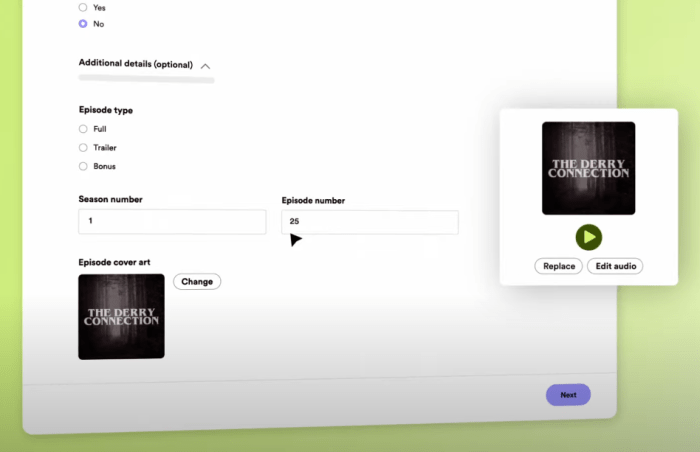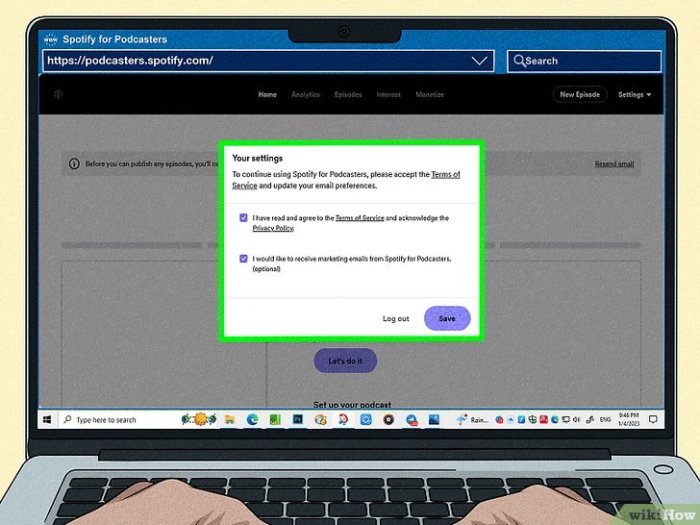Upload Podcast to Spotify is your comprehensive guide to getting your podcast on this massive audio platform. We’ll cover everything from preparing your podcast files to optimizing metadata and promoting your show after upload. This in-depth guide will walk you through the process, highlighting essential technical aspects, and offering practical tips for success on Spotify.
We’ll explore Spotify’s podcast platform, comparing it to other options. Understanding the technical requirements, such as file formats and bitrates, is crucial for a seamless upload. Metadata optimization is also key to making your podcast discoverable. We’ll provide actionable steps and best practices, plus troubleshooting common errors.
Spotify’s Podcast Platform

Spotify’s podcast platform has become a significant player in the audio landscape. It offers a robust suite of features for creators, making it an attractive option for podcasters of all levels. Beyond just hosting, Spotify provides tools for promotion and monetization, making it a comprehensive solution for reaching a wider audience.The platform’s ease of use and extensive functionalities make it a valuable tool for podcasters, allowing them to focus on content creation rather than technical aspects of hosting and distribution.
This ease of use is a key selling point, attracting both established and new podcasters.
Podcast Account Creation and Management
The process of creating and managing a podcast account on Spotify is generally straightforward. Users can typically sign up for a free account, then add their podcast details, including artwork, descriptions, and episode information. This process is usually intuitive and accessible to those with basic computer skills. Spotify provides detailed guides and support resources to assist users at every stage.
Podcast Upload Features
Spotify’s platform provides several features relevant to podcast uploads. These include the ability to upload episodes directly, managing episode metadata (like titles, descriptions, and release dates), and utilizing Spotify’s analytics tools to track podcast performance. The platform also allows for editing episode content, if needed. Metadata management is crucial for searchability and discoverability, while analytics help understand listener engagement.
Advantages of Using Spotify
Spotify offers a wide range of advantages to podcasters. Its vast user base provides significant potential for reach and exposure. Spotify’s built-in distribution capabilities can streamline the process of getting podcasts to listeners, eliminating the need for separate hosting platforms. The platform also offers tools for monetization, such as sponsorships and premium subscriptions. Furthermore, Spotify’s strong brand recognition and user engagement can be beneficial for podcasters looking to increase their audience.
Uploading a podcast to Spotify can be a bit of a process, but it’s worth it! Speaking of music, did you hear about Nick Cave and the Bad Seeds announcing a new live EP? It’s always exciting to see the release of new music from such an iconic band, especially a live recording. Hopefully, this announcement will inspire you to get your own podcast uploaded to Spotify, and maybe even find some inspiration from the music of Nick Cave and the Bad Seeds.
nick cave and the bad seeds announce new live ep Hopefully, that’ll give you a boost for your own podcast upload!
Disadvantages of Using Spotify
Spotify, while offering many benefits, also has some drawbacks. One potential concern is the platform’s control over podcast visibility and promotion. While Spotify offers promotion tools, the success of a podcast can still depend heavily on the platform’s algorithm and strategies for promoting new content. Additionally, the specific monetization opportunities offered by Spotify may not be suitable for all podcasters.
Key Elements for Podcast Uploads
Spotify emphasizes several key elements for successful podcast uploads. These include high-quality artwork, a compelling podcast description, and accurate episode metadata. Artwork is crucial for attracting listeners’ attention. A good description helps summarize the podcast’s content and purpose, drawing in listeners who are searching for specific topics. Accurate episode metadata allows listeners to easily find and access specific episodes.
Comparison with Other Podcast Hosting Platforms
Comparing Spotify to other podcast hosting platforms reveals differences in their approaches to podcast management. While Spotify’s ease of use and broad reach are strengths, other platforms might offer more granular control over technical aspects of podcast hosting and storage. The choice between platforms often comes down to individual needs and priorities. For example, some podcasters might prefer platforms with more control over their website or podcast feed.
Technical Aspects: Upload Podcast To Spotify
Podcast uploads to Spotify require meticulous attention to technical details to ensure optimal quality and a smooth user experience. Understanding the platform’s specifications is crucial for avoiding issues and maximizing the reach of your podcast. Proper file formats, bitrates, and sample rates are all essential components of a successful podcast upload.Spotify’s platform is designed to accommodate a wide range of podcast formats, but adhering to their guidelines is key to avoiding issues with playback.
Supported File Formats and Codecs
Spotify supports a variety of audio file formats for podcast uploads. Common formats include MP3, AAC, and M4A. Each format offers distinct advantages and considerations. The codec used within a file format dictates the compression and quality. For example, MP3 is a widely used, lossy format known for its smaller file sizes, while AAC and M4A are lossy formats, but often offer better sound quality at similar file sizes.
Choosing the right format and codec is crucial for balancing quality and file size.
Uploading your podcast to Spotify is a great way to reach a wider audience. It’s a straightforward process, but knowing the ins and outs of the platform can help. You might want to check out some of the creative ways others have successfully uploaded their podcasts to Spotify, like this fascinating exploration of the life and music of Warren Zevon, warren zevon warren zevon.
Ultimately, uploading your podcast to Spotify can be a rewarding experience, helping you connect with listeners and build your brand.
Required Bitrate and Sample Rate
For high-quality podcast uploads, Spotify recommends a bitrate of 128 kbps or higher for MP3, and 256 kbps or higher for AAC or M4A. The sample rate is another crucial factor. A sample rate of 44.1 kHz is commonly used and widely supported, but higher rates like 48 kHz can result in better audio fidelity. These technical specifications directly influence the clarity and richness of the podcast audio.
Impact of File Size on Upload Time and Quality
Larger file sizes generally lead to longer upload times, potentially causing delays for listeners eager to access your podcast content. Furthermore, excessively large files can impact the overall user experience, especially on lower-bandwidth connections. While higher bitrates and sample rates can result in higher-quality audio, they also contribute to larger file sizes. Finding the optimal balance between quality and file size is essential.
Uploading a podcast to Spotify can be a rewarding experience, but sometimes you just need a little inspiration. For a fresh perspective, check out some awesome remixes, like listen a trak remixes phoenixs trying to be cool. They’re a great way to boost your creativity, and once you’ve got the mojo going, you can get back to crafting that perfect podcast upload.
Ultimately, the goal is still the same: a successful podcast on Spotify!
Common Technical Issues During Uploads and Solutions
Several technical issues can arise during podcast uploads to Spotify. One common issue is encountering errors during the upload process, often due to compatibility problems with the file format or codec. Issues with file size, exceeding upload limits, or upload timeouts are also possible. These problems can be addressed by ensuring compatibility with the supported file formats, optimizing file size, and using a stable internet connection.
Comparison of File Formats
| File Format | Codec | Suitability for Spotify | Pros | Cons |
|---|---|---|---|---|
| MP3 | MP3 | Good, widely supported | Small file size, compatible with many devices | Potential loss of audio quality compared to higher-quality formats |
| AAC | AAC | Excellent, high-quality | Good balance between quality and file size, compatible with many devices | Slightly larger file size compared to MP3 |
| M4A | AAC | Excellent, high-quality | Good balance between quality and file size, compatible with many devices | Slightly larger file size compared to MP3 |
The table above provides a concise comparison of different file formats, outlining their suitability for Spotify podcast uploads. It highlights the trade-offs between file size, quality, and compatibility, allowing users to make informed decisions.
Promoting the Podcast

Getting your podcast noticed on Spotify takes more than just uploading it. A well-planned promotion strategy is crucial for attracting listeners and building a loyal audience. This involves leveraging various channels and understanding the nuances of Spotify’s platform.Effective promotion is about more than just shouting into the void. It’s about strategically reaching potential listeners who are likely to be interested in your podcast’s content.
Understanding Spotify’s tools and features is paramount, as is actively engaging with listeners on social media.
Spotify’s Promotion Tools and Features
Spotify offers a suite of tools to help you reach a wider audience. Utilizing these tools effectively can significantly boost your podcast’s visibility. This includes features like targeted advertising, podcast recommendations, and collaborations with other creators. Spotify’s algorithms play a crucial role in podcast discovery. By leveraging these tools, you can maximize your podcast’s exposure and increase its chances of being discovered by the right audience.
Social Media for Podcast Promotion
Social media platforms are indispensable tools for podcast promotion. Engaging with potential listeners on platforms like Twitter, Instagram, and Facebook, as well as others, allows you to build a community around your podcast. Sharing snippets of episodes, behind-the-scenes content, and engaging with listener comments are key strategies. This fosters interaction and builds anticipation for new episodes.
Podcast Promotion Strategies, Upload Podcast to Spotify
A well-rounded promotion strategy involves a combination of tactics. Here’s a table outlining various strategies, their advantages, and disadvantages:
| Promotion Strategy | Advantages | Disadvantages |
|---|---|---|
| Social Media Marketing | Reaches a broad audience, fosters community, and allows for direct engagement with listeners. | Requires consistent effort and time commitment. Effectiveness depends heavily on audience engagement and platform optimization. |
| Email Marketing | Allows for direct communication with subscribers, fostering loyalty and providing updates about new episodes. | Requires building an email list, which takes time. Can be ineffective if not managed correctly. |
| Guest Appearances on Other Podcasts | Exposure to a new audience interested in related topics, creating cross-promotion opportunities. | Requires outreach and coordination, can be time-consuming, and may not always result in substantial listener growth. |
| Paid Advertising on Spotify | Directly targets potential listeners based on specific demographics and interests, allowing for highly focused campaigns. | Can be expensive, requires a budget, and effectiveness depends on targeting accuracy. |
Optimizing Podcast Visibility on Spotify
Optimizing your podcast’s visibility on Spotify’s search results involves several crucial steps. Use relevant s in your podcast title, description, and episode titles. A compelling and accurate description is essential to attract listeners. Consider creating engaging episode titles that accurately reflect the content. Comprehensive episode descriptions also enhance visibility.
Consistent uploads and a high-quality podcast feed also contribute to your podcast’s ranking on the platform.
Last Point
Successfully uploading your podcast to Spotify isn’t just about the technical aspects; it’s about understanding your audience and crafting a compelling listening experience. This guide equips you with the knowledge and tools to navigate the process, from preparation to promotion. By following these steps, you can confidently launch your podcast on Spotify and reach a wider audience.


